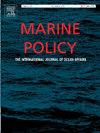AIS data underrepresents vessel traffic around coastal Scotland
IF 3.5
2区 社会学
Q2 ENVIRONMENTAL STUDIES
引用次数: 0
Abstract
Automatic Identification System (AIS) data is often used as a proxy to quantify vessel densities and estimate their associated impacts (e.g. emissions, underwater noise, likelihood of collision with marine megafauna), yet it is increasingly acknowledged that AIS data does not fully capture all vessels that may be present within a given area. Therefore, impacts that are evaluated using only AIS-based vessel data (e.g. counts) are likely underestimating the volume of vessel traffic, and thus the potential and scale that effects may occur. The extent of this underestimation is unclear due to the lack of data on the volume and distribution of vessels that are not transmitting AIS. To investigate this, > 1800 hours of land-based and at-sea visual surveys were conducted across nine Scottish Marine Regions between 2019 and 2024, collecting data on coastal vessel activity (<10 km of shore). These data were compared with corresponding AIS data to quantify AIS vs non-AIS traffic. Non-AIS vessels were present during 67 % of the total time surveyed. Of the vessels recorded, only 43 % were broadcasting AIS. AIS transmission rates were varied between seasons (range = 38–55 %), regions (range = 20–58 %), and by vessel type (range = 0–95 %). Given AIS data is increasingly being used to quantify vessel activity and predict associated impacts, it is vital that further consideration is given to the volume of vessel traffic absent from these datasets and predictive efforts. Underestimation of actual vessel traffic present, and the potential associated impacts may lead to inadequate policies, management or mitigation efforts.
AIS数据不足以代表苏格兰沿海地区的船舶交通
自动识别系统(AIS)数据通常被用作量化船舶密度和估计其相关影响(例如排放、水下噪音、与海洋巨型动物碰撞的可能性)的代理,但人们越来越认识到,AIS数据并不能完全捕获给定区域内可能存在的所有船舶。因此,仅使用基于ais的船舶数据(例如计数)来评估影响可能会低估船舶交通量,从而可能发生影响的潜力和规模。由于缺乏关于不传输AIS的船只的体积和分布的数据,这种低估的程度尚不清楚。为了调查这一点,在2019年至2024年期间,在苏格兰九个海洋区域进行了>; 1800 小时的陆基和海上目视调查,收集了沿海船只活动的数据(<;10 公里的海岸)。将这些数据与相应的AIS数据进行比较,以量化AIS与非AIS交通。在调查的总时间中,有67% %的时间存在非ais血管。在记录的船只中,只有43% %在广播AIS。AIS传播率因季节(38-55 %)、地区(20-58 %)和船舶类型(0-95 %)而异。鉴于AIS数据越来越多地被用于量化船舶活动和预测相关影响,进一步考虑这些数据集和预测工作中缺失的船舶交通量至关重要。对现有实际船舶交通量和潜在相关影响的低估可能导致政策、管理或缓解努力不足。
本文章由计算机程序翻译,如有差异,请以英文原文为准。
求助全文
约1分钟内获得全文
求助全文
来源期刊

Marine Policy
Multiple-
CiteScore
7.60
自引率
13.20%
发文量
428
期刊介绍:
Marine Policy is the leading journal of ocean policy studies. It offers researchers, analysts and policy makers a unique combination of analyses in the principal social science disciplines relevant to the formulation of marine policy. Major articles are contributed by specialists in marine affairs, including marine economists and marine resource managers, political scientists, marine scientists, international lawyers, geographers and anthropologists. Drawing on their expertise and research, the journal covers: international, regional and national marine policies; institutional arrangements for the management and regulation of marine activities, including fisheries and shipping; conflict resolution; marine pollution and environment; conservation and use of marine resources. Regular features of Marine Policy include research reports, conference reports and reports on current developments to keep readers up-to-date with the latest developments and research in ocean affairs.
 求助内容:
求助内容: 应助结果提醒方式:
应助结果提醒方式:


